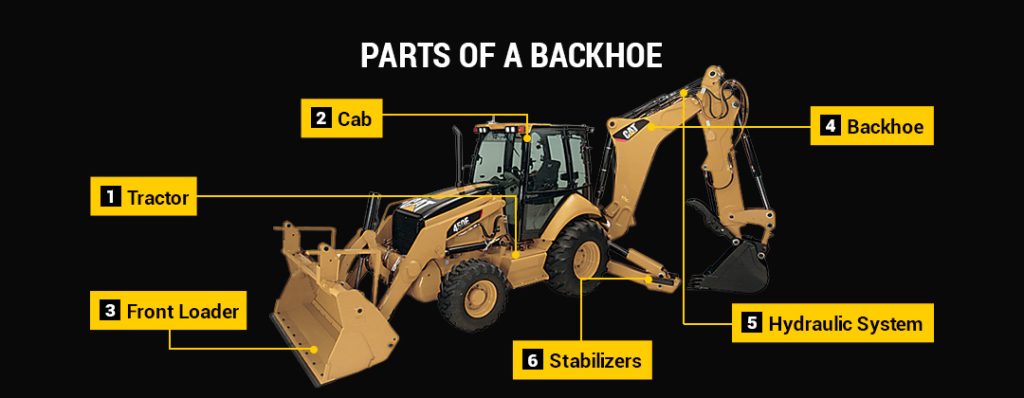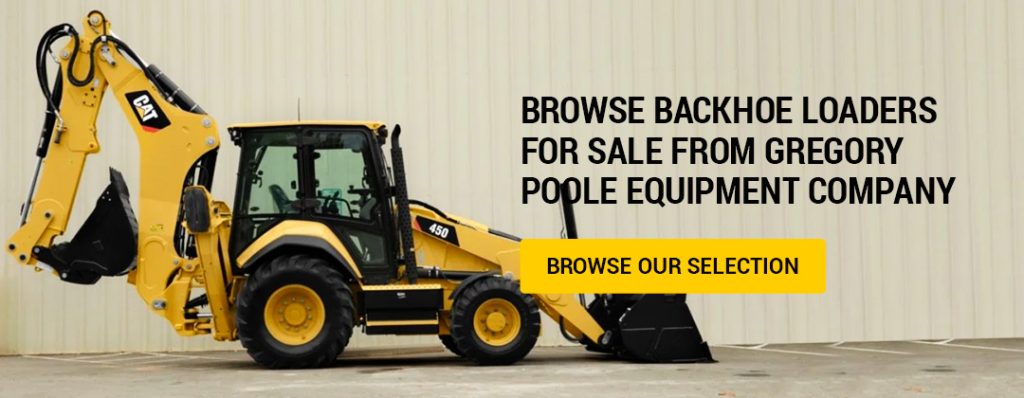
When working with backhoe loaders, understanding the anatomy of these pieces of equipment is essential. You can benefit from exploring what makes up a backhoe and the defining characteristics of each component. Familiarizing yourself with each part and its function can help you choose the right models, support optimal maintenance and repair practices, boost safety and enhance operational efficiency.
At Gregory Poole Equipment Company, we offer a wide selection of backhoe loaders for sale, and our team wants to help you understand your fleet so you can make the most out of every machine in your lineup.
A backhoe loader is an incredibly versatile piece of construction equipment. Unlike a traditional loader, they feature attachments on the front and back of the tractor, supercharging their capabilities and enabling them to tackle more applications.
These machines are known for their compact size and excellent maneuverability, making them a great addition to any equipment fleet.
Many industries, from construction to roadwork to landscaping, leverage backhoe loaders. They are designed to tackle many different jobs, including:
Backhoe loaders can provide many advantages for operators, including:

Explore the primary backhoe components below:
The tractor serves at the base of the backhoe loader and houses the machine’s engine. This main component is designed to take on heavy-duty work and protect the powerful engine that drives the hydraulic system.
The tractor features the operator cab and four rugged tires that support excellent maneuverability on a job site. It also supports the front attachments and the rear backhoe. Thanks to its low center of gravity, the tractor supports stability and traction on various terrains.
The cab on a backhoe loader is the operator’s workspace. It provides a comfortable and safe area to drive the machine. The machine’s cab features all of the controls for operation, including the joysticks, levers and buttons to manipulate the front loader attachment and the backhoe.
Newer models are typically outfitted with features to enhance comfort and safety, including:
Many cabs feature advanced technologies, including digital displays and cameras, to help operators increase visibility and monitor equipment performance during operation.
A front loader on a backhoe refers to the part used for loading, lifting and transporting materials on a job site. The front loader features different backhoe components, including a hydraulically-powered arm with a bucket attachment on the end.
Front loaders are essential for hauling materials such as soil, sand or gravel. You can switch out the bucket for other attachment options, saving time and boosting operational efficiency. Front loaders are available in different configurations and sizes to suit different material handling applications.
The backhoe plays an integral role in digging operations. It is mounted to the tractor’s rear and features a boom, stick — sometimes called the arm — and backhoe attachment used for various construction, landscaping and utility jobs.
The backhoe boom is the component that operators lift and lower to perform different applications, including excavation and trenching. It is the machine’s primary lifting component and is powered by the backhoe loader’s hydraulic systems. You can find backhoes in various sizes and configurations to fit your project requirements.
A backhoe loader’s hydraulic system is responsible for powering the movement of its components, including the front loader and backhoe attachments. This system utilizes pressurized hydraulic fluid to create the force required to operate the machine’s cylinders.
The hydraulic system enables operators to exercise precise control when lifting, lowering, tilting and extending the backhoe’s components. It offers the power and efficiency needed to tackle heavy-duty applications quickly and accurately. Proper maintenance of the backhoe’s hydraulic system is essential for supporting the optimal performance of the entire machine.
A key safety feature on a backhoe load is the stabilizer leg. You can deploy these components on either side of the tractor to ground the machine and prevent tipping. They help ensure the machine remains secure while lifting heavy loads and digging into terrain.
Stabilizers enhance the backhoe’s base and help the machine stay balanced to combat accidents and injuries. This part is key to safe, secure and efficient operations in various working conditions.
If you’re interested in introducing a new backhoe loader to your fleet, keep these considerations in mind:

For over 70 years, Gregory Poole Equipment Company has provided customers in eastern North Carolina with industry-leading equipment. We can help your business get the tools and machines you need to maximize your return on investment and supercharge success.
We offer competitive financing programs to suit your company’s unique requirements and an extensive range of work tools and accessories to help your team boost operational efficiency. You can also rely on Gregory Poole for service support to ensure your equipment always functions at its best.
Browse our selection of backhoe loaders online, or find the Gregory Poole location nearest you today.